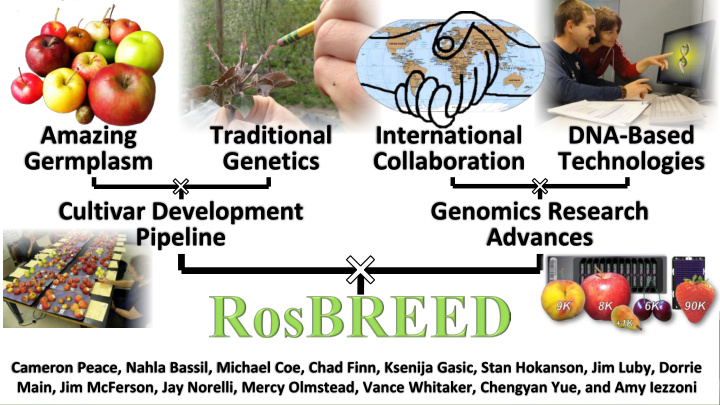



Amazing Traditional International DNA-Based Germplasm Genetics Collaboration Technologies Cultivar Development Genomics Research Pipeline Advances Cameron Peace, Nahla Bassil, Michael Coe, Chad Finn, Ksenija Gasic, Stan Hokanson, Jim Luby, Dorrie Main, Jim McFerson, Jay Norelli, Mercy Olmstead, Vance Whitaker, Chengyan Yue, and Amy Iezzoni
Outline of Presentation Amazing Germplasm × Traditional Genetics International Collaboration × DNA-Based Technologies Cultivar Development Pipeline × Genomics Research Advances
The Rosaceae Family
Amazing Germplasm!
Features of Rosaceous Crops • Product quality is paramount • Clonally propagated • Perennial • Often long juvenility • Often obligate outcrossers • Often high heterozygosity • Sometimes polyploid • Few generations in cultivation, much diversity in primary genepools huge genetic gains possible
Traditional Genetics • Crossing & selecting mostly by phenotype • Breeders often rely • Quantitative genetics rarely used on serendipity • Challenges: large plant sizes, long juvenility, disease resistances combined with superior quality
Cultivar Development Pipelines • Need for much public breeding (some crops/regions not commercially viable?) • Many exciting releases • Cultivar development pipelines are functional but inefficient
-
Strong Spirit of Collaboration
International Research Community Hub
Rosaceae Community Collaboration Whole genome sequences U.S. International RGC2 Rosaceae US RosEXEC Genomics NEW Z’LAND Conferences RGC3 CHILE RGC4 US – Eur S. AFRICA Rosaceae RGC5 ITALY Mapping Consortium SNP arrays U.S. Technology Roadmap for White Paper: Tree Fruit US Rosaceae Production Rosaceae Specialty Crops Planning Workshop Genomics, Genetics, & Breeding Initiative
Genomics Research Advances • Powerful genomics resources and many discoveries • Little translation to breeding application
Cultivar Development Genomics Research Pipeline Advances
Genomics-Assisted Breeding The Chasm! Genomics resources (e.g., whole genome sequences) DNA Decision information support More efficient development of new cultivars
The Chasm! DNA Decision information support
Some Reasons for the Chasm DNA Decision Reported QTLs themselves: information support • Trait low priority / low value • Weak linkage • Different germplasm • Unknown functional alleles • Unknown genetic action • Unknown linkage relationships • Unknown environment effects • Unknown management effects No suitable DNA testing services Not believed to be cost efficient No training in routine DNA testing
Bridging the Chasm DNA Decision information support
“RosBREED 1” • Funded by USDA Specialty Crop Research Initiative • $7.2 M federal • Sep 2009 – Aug 2014 • Project Directors: Amy Iezzoni Cameron Peace
RosBREED 1 Outcomes • Socio-economic values for levels of breeding traits • Genomics resources and DNA information: SNP array genome scans, QTLs
RosBREED 1 Outcomes • Practical tools for breeding use: DNA tests for many breeding-relevant traits • DNA information about breeding germplasm: genetic potential of parents, seedlings, selections, cultivars
DNA Tests in 2009
DNA Tests Now APR MAY JUN JUL AUG SEP JUN JUL
RosBREED 1 Outcomes • Trained the next generation of breeders! … and many of the current generation
RosBREED 1 Outcomes • DNA-informed breeding is now conventional! U.S.-wide survey of Rosaceae breeders (early 2014): Agree that “Genetic marker information will 62% be included in 2014 in how my organization addresses plant breeding & selection”
“RosBREED 2” • Funded by USDA MSU Univ Florida Specialty Crop Mercy Olmstead Amy Iezzoni (PD) Research Initiative Jim Hancock Vance Whitaker Univ Arkansas Bill Shane John Clark Cornell Univ • $10.0 M federal Clemson Univ Susan Brown Ksenija Gasic Univ New Hampshire Steve Kresovich Tom Davis • Sep 2014 – Amy Lawton-Rauh Gregory Reighard WSU Aug 2019 Chris Saski Cameron Peace (coPD) Guido Schnabel Lisa DeVetter USDA-ARS • Project Directors: Kate Evans Nahla Bassil Texas A&M Karina Gallardo Richard Bell Amy Iezzoni Univ Minnesota Dave Byrne Des Layne Chad Finn Cal Poly State Rex Bernardo Cameron Peace Dorrie Main Jay Norelli Kelly Ivors Stan Hokanson Univ CA-Davis Vicki McCracken Jim Luby Univ Queensland Tom Gradziel Pat Moore Chengyan Yue Craig Hardner Carlos Crisosto Nnadozie Oraguzie
RosBREED 2 Vision U.S. rosaceous crop breeding programs will exploit genetic resources, applying modern genomics tools to efficiently, accurately, creatively, and rapidly deliver new cultivars with market-essential horticultural quality and producer-required disease resistances to enhance consumer demand and mitigate stakeholder risk for rosaceous fruit, nut, and floral products.
RosBREED 2 Breeding Programs
RosBREED 2 Breedging Germplasm Levels MARKETING PRODUCTION Innovative, Elite selection superior, performance risk-mitigating new cultivars Creative, efficient, Seedling selection accurate, rapid Parent selection breeding Germplasm Accessible development natural diversity
RosBREED 2 Transdisciplinary Approach Objectives
Objective 1
Objective 2
Objective 3
Objective 4
Objective 5
Haploblocking
Haploblocking Characterize effects and ancestry Divide each of each variant – haplotypes chromosome into BLIGHT extremely positive segments that are RESISTANCE strongly positive non-recombining in positive SIZE historical, selected mildly positive neutral germplasm mildly negative – haploblocks POST - ZYGOTIC negative SEGR . DISTORTION strongly negative Target tight extremely negative linkages to over-represented break, if neutral SWEETNESS under-represented desired
The Pedigree of RosBREED Enhanced breeding efficiency , accuracy , speed , & creativity
The Children of RosBREED
Acknowledgements RosBREED is supported by the USDA-NIFA-Specialty Crop Research Initiative by a combination of federal and matching funds (grant number 2014- 51181-22378).
Questions? www.rosbreed.org
Recommend
More recommend